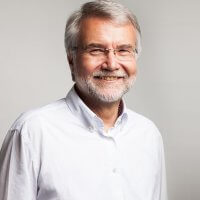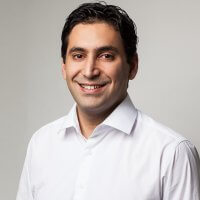
There is more to the eye than just the pupil
Information on
eye and eyesight
Eye and vision
As ophthalmologists, we’re fascinated by the eye
We’re amazed by its functionality and versatility. Vision is the most important sense – and the eyes are multi-talented: More than ten million data per second can be taken in and more than 600,000 colour shades can be distinguished – when in a healthy condition.
Six different muscles move our eye right into the direction into which we’re looking.
This means a multiple hundred thousand times eye muscle activity every day.
Only about ten percent of the population have blue eyes. Most people with blue eyes – the colour is determined by the iris – stem from Scandinavia and the Baltic states.
Eye functions
The act of seeing consists of the following phases:
We look at an object – and the reflecting light passes through different parts of the eye:
- Cornea
- Anterior chamber of the eye
- Iris
- Optical lens
- Vitreous body
Finally, it reaches the retina. This is where the photoreceptors are and the area of sharpest vision (yellow spot or macula).
The actual seeing is performed inside the brain. The light that is coming in through the eye is transformed by over 100 million photoreceptors into nerve impulses which the optic nerve transports into the brain. Here, the actual image is created.
70 percent of all data taken in is processed by our visual system
But the eyes can also be called a mirror of the soul. They can colloquially:
- “glow with happiness”
- “catch a glimpse”
- “make eyes” at someone
- We “keep an eye” …
and, in more negative meanings, we „roll the eyes“ or „scratch someone’s eyes out“ or, most visible, show with tears how we feel inside.
The healthy eye
What is eye health?
An eye weighs just about 20 gram and is a highly complex organ that performs a unique function by sensing the world visually for you. For us as ophthalmologists, it’s all about the healthy eye which is the centre of our daily work.
Characteristics of healthy eyes
- the cornea and the eye lens are transparent and clear
- normal intra-ocular pressure
- good eye perfusion
Good vision is not granted. Especially old people can be affected by certain diseases. Wide-spread age-related eye diseases are, for example, age-related macular degeneration or cataract.
Chronic diseases like diabetes may also have a massive impact on eye health and vision.
Protecting the eye and maintaining vision
To protect something like „the apple of one’s eye“ has a deep meaning:
Eyesight is a precious thing that needs special care.
The eye is harmed by:
- hours of screen work
- reading and working with insufficient lighting
- sunlight (UV rays)
- long driving at night
- unhealthy nutrition
Ways to protect your eye health:
- wearing of sunglasses with 100 % UV protection
- keeping a 50 cm distance from the computer screen
- possibly wearing of special glasses for screen work
- letting the eyes wander around now and then
- healthy nutrition with eye protection ingredients
Nutrition for good eyes and vision
These nutrients are important sources of energy for the eye:
- Vitamin A, as in fish, eggs, butter, whole milk, cheese
- Provitamin A (beta-carotin), yellow, red and green fruit and vegetables
- Vitamin C, as in fruit and fruit juice
- Zeaxanthin: red grapes, green beans
- Lutein: green pepper, pumpkin, green cabbage
Short-sightedness
What is short-sightedness?
Short-sightedness – or myopia in ophthalmological language – is a wide-spread phenomenon: About 1.6 billion people worldwide are affected by short-sightedness.
What causes short-sightedness?
The reason for short-sightedness – usually emerging during childhood – is an undesirable development of the eye. Two different aberrations occur:
- the ocular globe is a little too long
- lens and cornea are refracting the incoming light too strong
As a consequence, the focal point lies before the retina and the image becomes blurred. If the ocular globe is prolonged for about only one millimetre, a short-sightedness of circa three dioptres (–3.0) is the result.
Severe short-sightedness
There are also cases of very strong short-sightedness – „high myopia“.
If that is the case, the person affected has values of more than –6 dioptres.
In Germany, 1–3 percent are affected of very strong pathological short-sightedness: high myopia.
Long-sightedness
What is long-sightedness?
People who can see objects in the distance very good but not so in proximity – for example when reading or doing needlework – suffer from long-sightedness (hyperopia).
What causes long-sightedness?
This aberration of the eye can have the following reasons:
- the ocular globe is a little too short
- the lens is refracting the incoming light too little
As a consequence, the focal point lies behind the retina.
The lenses of children and teenagers usually compensate this aberration. By deforming, it adapts to the situation. This is what ophthalmologists call accomodation.
Middle-aged people with a mild form of long-sightedness often need reading glasses as a visual aid.
Severe long-sightedness
People suffering from severe long-sightedness need glasses or contact lenses already in their youth as visual aid.
In the eyeglass prescription of long-sighted people, you will find a plus sign before the dioptric number, for example, +2.0 dioptres.
Presbyopia
Visual problems that relate to the person’s age are not connected to the length of the ocular globe. If people at around 40 – 45 years of age experience for the first time visual problems in their proximity, another reason is very likely.
The elasticity of the lens and eye muscles diminishes.
As age proceeds, the lens and certain ocular muscles lose their elasticity. This makes it harder and harder for the eye to focus.
As a consequence, this visual limitation can expand to middle and great distances.



